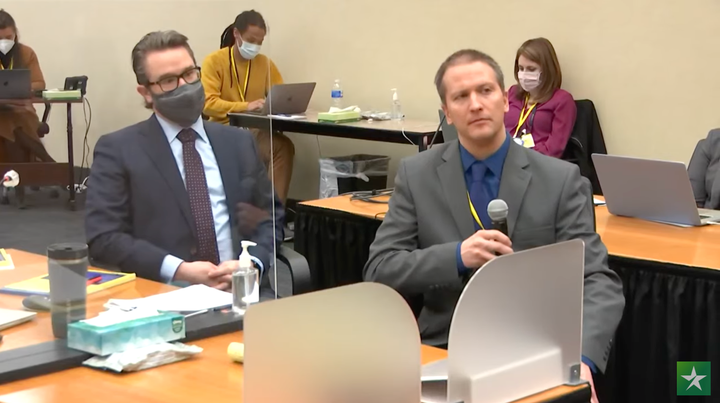Former Minneapolis police officer Derek Chauvin was convicted on Tuesday of second-degree murder, third-degree murder and second-degree manslaughter for killing George Floyd, a Black Minnesotan whose death set off nationwide protests against racist police brutality. Chauvin could face decades in prison.
The fact Chauvin was arrested and charged was itself unusual. Each year, police shoot and kill roughly 1,000 people, according to The Washington Post, which has been tracking fatal shootings by on-duty police officers since 2015. But between the beginning of 2005 and June 2019, just 104 non-federal law enforcement officers have been arrested on murder or manslaughter charges related to an on-duty shooting, researchers at Bowling Green State University found.
And of those 104 officers who were arrested, only 35 were convicted of a crime — 15 pleaded guilty and 20 were convicted by a jury. Chauvin’s conviction, therefore, was an anomaly.
Even when police officers are convicted of killing, it is rarely on murder charges. Instead, 31 of those 35 convictions were for lesser charges, including manslaughter, negligent homicide and reckless discharge of a firearm. Those charges generally carry more lenient sentences than a murder conviction.
Racism is a key reason why, in America, police officers rarely face criminal punishment when they take another person’s life. Black people are more than twice as likely as white people to be killed by the police, and white jurors may empathize less with a Black victim. And although public trust in the police is at its lowest point in decades, there are still plenty of Americans who are inclined to trust a law enforcement officer’s narrative and, if put on a jury, would be reluctant to convict a cop.

Even jurors who aren’t enthusiastically pro-law enforcement may vote not to convict because of cops’ broad legal authority to kill. In the 1980s, the Supreme Court established that police officers are allowed to use deadly force if they believe their life or the lives of others are in danger — even if evidence shows that there was never any threat.
Timothy Loehmann, the police officer who in 2014 shot and killed 12-year-old Tamir Rice, “had reason to fear for his life,” prosecutor Timothy McGinty claimed at the time after a grand jury decided against indictment. It would have been “unreasonable” to expect the police officer to wait and see if the young boy’s toy gun was real, McGinty said.
This standard can make prosecutors, who rely on cops to gather evidence, hesitant to move forward with a case that could complicate their professional relationships and is unlikely to succeed. And even if a prosecutor wants to pursue a case, they can face resistance getting evidence from the police, who often prioritize protecting their own.
Given the way Chauvin killed Floyd, he could not make a convincing argument that he used force because he believed he was in imminent danger. Rather than making a split-second decision to fire his gun, Chauvin kneeled on Floyd’s neck for 9 minutes and 29 seconds while Floyd was unarmed and handcuffed, physically incapable of posing a threat.
During that time, Floyd told Chauvin he couldn’t breathe and cried out for his “Mama.” In videos, Chauvin appears calm while restraining Floyd, even as witnesses warned that Floyd had stopped moving and pleaded with the cops to get off of him.
“Racism is a key reason why, in America, police officers rarely face criminal punishment when they take another person’s life.”
Instead of claiming self-defense, Chauvin’s defense centered around the improbable claim that Floyd just happened to die of other causes — hypertension, heart disease, adrenaline, drug use — at the exact time that Chauvin applied consistent pressure to his neck for nearly 10 minutes. This argument, which leans on racist tropes depicting Black men as drug-crazed addicts, is contradicted by the two medical examiners who conducted autopsies on Floyd’s body.
Both the Hennepin County medical examiner and doctors retained by Floyd’s family to conduct a private autopsy concluded the manner of his death was homicide. The county described the cause of death as “cardiopulmonary arrest complicating law enforcement subdual, restraint, and neck compression” and the private autopsy found the cause of death was mechanical asphyxia.
Prosecutors did not have to prove that Chauvin’s use of force was the only reason Floyd died, but that it was a “substantial causal factor.”
Even after it became clear that Floyd was unresponsive, Chauvin made no effort to save his life. Instead, he continued kneeling on Floyd’s neck. Derek Smith, the paramedic who took Floyd to the hospital, testified at trial that Chauvin was still pressing down on Floyd’s neck as Smith checked for a pulse and was unable to detect one. The police officer didn’t let up even when Floyd appeared to be dead.
Perhaps that brutality is why Minneapolis Police Chief Medaria Arradondo testified against his former colleague. The same people who uphold a system that allows police to brutalize the public without consequence insisted that Chauvin did not represent them.
“This is not an anti-police prosecution, it’s a pro-police prosecution,” prosecutor Steven Schleicher said in his closing remarks. But Chauvin’s behavior was not unusual. The white police officer acted as if his job empowered him to exert any level of force over a Black man until he submitted completely, even if it resulted in the man’s death.
The only thing unusual about Chauvin is that he will face consequences.
